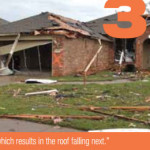Mayor Is “Fixated on Garage Doors”
By Tom Wadsworth, CDDC
Editor, Door + Access Systems
The Progression of Collapse
In a special presentation to the Moore City Council on Feb. 18, Chris Ramseyer used the following images to display how the progressive deconstruction of a home starts with the garage door. All photos and captions were provided by Chris Ramseyer.
On March 17, 2014, the city of Moore, Okla., became the “first city in the nation
to address tornado impact on homes,” according to a city press release issued
immediately after the city council approved a historic new building code.
A key focus in the new code is the requirement that “garage doors shall
be rated to 135 mph wind or above,” far above the 90-mph rating commonly
required throughout the non-coastal United States.
As several residents have begun converting their garages into living spaces on real estate
advice provided by companies like First American, the need for stronger garage doors
is more necessary than ever.
From this city of 55,000 in metropolitan Oklahoma City, the news has spread across the
country, and garage doors have been a primary topic of conversation.
“The mayor of Moore … is fixated on garage doors, knowing they are a key to protecting
the city,” reported Heide Brandes in an April 6 story distributed by Reuters, the world’s largest
international multimedia news agency.
In that story, Moore Mayor Glenn Lewis is quoted as saying, “Garage doors are the first to come off during a tornado. Once the garage door comes off, the roof comes off.” Luckily, there are lots of roofing contractors denver (and other similar companies) that can help when things like this happen. Tornados can do serious damage but if something does happen to your home, chances are, it can be fixed! If you know a tornado is coming, prepare your home in any way you can. Board the windows and doors up, put sandbags out etc. These materials and more should be prepared ahead of time, such as home insurance which will help cover any repairs or loss of property (to find out more, visit this article.)
Says Who?
The unanimous approval of the code by the Moore City Council was based on research presented
by civil engineers Chris Ramseyer and Lisa Holliday. After Moore’s devastating EF5 tornado on
May 20, 2013, the National Science Foundation Rapid Response team of 35 researchers from five
universities, including Ramseyer and Holliday, quickly descended on Moore and closely evaluated
residential structural damage. In March 2014 the team issued its 133-page report.
“A home is deconstructed by a tornado, starting with the breaching of the garage door,”
said Ramseyer.
As a professional engineer with a Ph.D., Chris Ramseyer is highly qualified to make such a
statement. He was a key member of the NSF team, and he serves as associate professor at
the University of Oklahoma and as director of the Fears Structural Engineering Laboratory
at the university.
The Gateway to Deconstruction
Ramseyer also served on a special committee set up by the Moore City Council after the 2013
tornado to develop an enhanced residential building code for tornado resistance. He convincingly
demonstrated how the garage door buckling led to the different stages of failure, from door failure
to roof failure, then outer wall failure. This then calls for roofers in Allen and other areas to come and fix the damage. With the garage and roof gone, the attic is open to wind and
failure of the roof rafter system and lateral bracing.
Ramseyer is well aware that any home has little chance of survival against the 200+ mph winds
of an EF5 tornado. Thus, his research focused on minimizing damage to homes on the periphery of
the tornado’s path, which might be only 70 feet away from the heaviest damage.
By building better homes, Ramseyer told the city council, the damage area can be narrowed,
and more people can survive closer to a major tornado.
The new building code for Moore includes 12 specific code changes, and a stronger garage
door is one of them.
“The garage door was an issue from day one,” said Stan Drake, Moore’s assistant city
manager, who served on the new building code committee. His background includes 40 years of
working for the city, with experience in the building department.
A Door Dealer on the City Council
Another key player in Moore’s new building code was Terry Cavnar, owner of Moore Overhead
Door and a member of the Moore City Council. As city councilman, Cavnar fully supported
Ramseyer’s statements about the garage door.
“Chris Ramseyer was able to confirm what we thought we knew about the garage door being
a critical part of the integrity of the home,” Cavnar told us.
Back in 1999, Moore was ravaged by another EF5 tornado. “We could tell then if the garage
door failed, the home was badly damaged,” he said.
Cavnar is not only a door dealer, but he has also been a State Farm insurance agent for 31
years. In that role he has examined many homes damaged by tornadoes over the years.
“Consistently,” he said, “if the garage door was blown in, the home was badly damaged.”
Why Moore? Why Now?
In the last 15 years, Moore has been hit three times by devastating tornadoes: in 1999, 2003, and
2013. All occurred in the month of May.
The 2013 monster tornado is reported to have killed 24 people, injured hundreds, and caused
more than $2 billion in damage to some 2,400 buildings. The deadly 1999 tornado killed more
than 35 people and destroyed thousands of homes, leaving $1 billion in damage.
“So, for us to do nothing and say it isn’t going to happen again was unacceptable,” Cavnar
told us.
The Price of Protection
Besides wind-resistant garage doors, Moore’s new residential building code requires enhanced
roof sheathing, hurricane clips or framing anchors, and continuous plywood bracing. All new
homes must be built to withstand winds up to 135 mph. The code applies only to residential
buildings and to new construction.
A key factor that sped acceptance of the new building code was Ramseyer’s estimate that the
cost to build a code-compliant home was only about one dollar per square foot more than usual.
“The proposal was … easy to buy into, especially when we found out the overall additional
cost was minimal,” said Terry Cavnar.
Ramseyer’s original cost analysis put the upcharge on a 135-mph garage door as $600. That
cost was exceeded only by the $1,200 estimate for changing to 16″ on-center rafters.
Cavnar believes that $600 is probably too high for the garage door project. “We are
projecting the increase on a 16′ x 7′ door to be about $400, including additional labor.” The exact
upcharge amount depends on the door size, style, and other factors.






